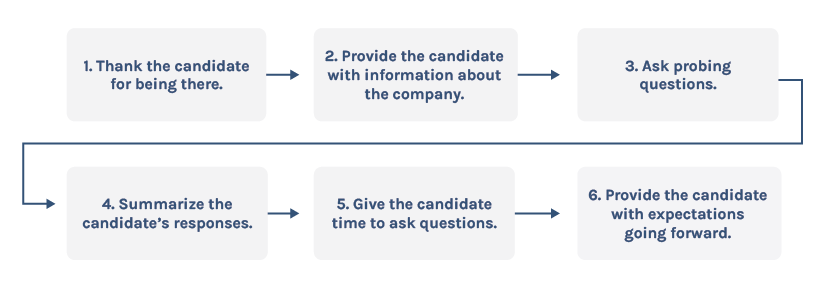Recruiting and Interviewing Training
Knowing how to effectively recruit and interview candidates can be overwhelming. This class will discuss how to read and evaluate resumes, get the most out of telephone screenings, conduct a positive interview, ask behavior-based questions and evaluate all of the facts.
1. Finding Potential Candidates
2. Resume and Cover Letters
Everything we’ve discussed concerning the resume is true of the cover letter as well. For example, if certain qualities are mentioned in the job description, the candidates should relate their experience to these qualities. Some of these job requirements are universal, so these qualities should still be addressed in the cover letter, even if the candidate does not have a copy of the job description.
Read the cover letter below and notice how the candidate makes it a point to bring out the specific skills she acquired in her professional experience.
While employed at Dreams incorporated, I learned to organize my time and projects to meet tight deadlines. In addition, I successfully led a team of six graphic designers with different talents and experience to exceed our customer’s expectations. Throughout my college and professional careers, I enjoyed solving complex problems, which contributed to my success in achieving a 3.8 average as a math major in college. I am confident that the skills I have developed will be a great asset to your underwriting team.
In this cover letter, she successfully illustrated how her experience provided her with skills that are transferable from an artistic position to a business position. This cover letter not only shows her awareness of the relationship between her actual job responsibilities and the quality she acquired from them but it also demonstrates her ability to communicate in a concicse, meaningful way. Kep in mind as you begin reviewing the resume and cover letter that these two documents provide a first impression of the candidate. That’s why it’s so important to look for quality in every aspect of your review of these items.
If you decide not to pursue the candidate further, send a letter letting them know that their background does not match the requirements for the current position. Don’t allow a candidate to hang in limbo, wondering if they will be interviewed.
3. Phone Screenings
Phone Screening Example
Let’s listen in on a phone interview. Note the questions asked by the interviewer and listen for cues as to whether or not you will bring the candidate in for an interview.
If you decide to interview the candidate, do your best to schedule the interview within a week of your decision to interview. Always put yourself in the candidate’s shoes. Be flexible; accomodate the candidate’s schedule by suggesting interview times before or after their work hours, if necessary. Also, let the candidate know how long they will be in the office so they can schedule accordingly.
4. The Interview
Here is a map that will navigate you through the interviewing process:

First, thank the candidate for being there. Give information about your company and the position. Ask questions. Summarize what you have heard, give the candidate the opportunity to ask questions, and finally, provide a timeline for the completion of the search and what the candidate can expect.
5. Asking the Right Questions
A crucial component of the interviewing process is asking good questions. If you don’t get the information you need to make a decision, then it is probably because you are not asking the right questions.
It’s important to ask questions that relate to:
- Requirements of the position
- Qualities that your company values
- The cover letter and resume
- The phone screening
Ask questions that will allow candidates to demonstrate certain skills. This will help you determine what level of experience the person has.
|
Don’t ask:“Do you have good communication skills?” Ask:“What kind of writing did you have to do in your previous job (or while you were in school)?” |
|
Don’t ask: “What would you do if you had several projects to complete in a short amount of time?” Ask: “Tell me about a time when you had to manage several priorities at the same time.” A candidate could make up an answer or not know what they would do simply because they have never been in such a situation. |
Peeling the Onion – Video Examples
Nervous Candidate
In this example, Cindy discovered a lot about Drew. Not only did she find out he did do some writing as the editor of the paper, but he also liked that element of his job the most. He doesn’t like to do the detail work, which is a component of the job, but he does like working in a fast-paced environment. She also discovered that he likes and is probably good at interacting with others.
Experienced Candidate
In this interview, while Cindy was probing for information concerning John’s leadership, she was also looking for additional information about his passion to excel, his teamwork, and what he values in leadership. Core values of our organization. These will help you determine whether the candidate is a good match for your company.
5. Poor Interview Example
Below is a demonstration of what a poor interview looks like. As you watch the interview, jot down some of your observations about what Cindy, the interviewer, does or says or fails to do or say that make this a poor interview.
Poor Interview Example
Review of Poor Interview
6. Good Interview Example
Below is a demonstration of what a good interview looks like. As you watch the interview, jot down some of your observations about what Cindy, the interviewer, does or says that make this a good interview.
Good Interview Example
Review of Good Interview
There is a lot of skill and practice that contribute to a successful interview process on both ends of the table. Remember – prepare, prepare, prepare. If the interviewing process is executed correctly, you will feel absolutely confident about your final decision.
